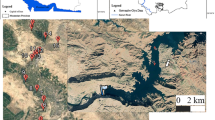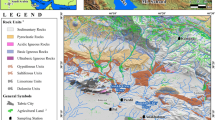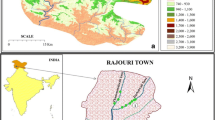Abstract
Aji-Chay River is one of the most important surface reservoirs of northwest of Iran, because it passes through Tabriz city and discharges to Urmia Lake, one of the largest permanent salty lakes in the world. The main objectives of the present study are to evaluate its overall water quality and to explore its hydrogeochemical characteristics, including the potential contamination from heavy metals and metalloids such as Co, Pb, Zn, Cd, Cu, Cr, Al and As. For this purpose, 12 water samples were collected from the main river body and its tributaries within Tabriz plain. The Piper diagram classified water samples mainly into Na–Cl and secondary into Ca–HCO3 and mixed Ca–Mg–Cl types, denoting a profound salinization effect. The cross-plots showed that natural geochemical processes including dissolution of minerals (e.g., carbonates, evaporites and silicates), as well as ion exchange, are the predominant factors that contribute to fluvial hydrogeochemistry, while anthropogenic activities (industrial and agricultural) impose supplementary effects. Cluster analysis classified samples into two distinct clusters; samples of cluster B appear to have elevated electrical conductivity (EC) values and trace metals concentrations such as Co, Pb and Cd, while SiO2 and Zn are low in comparison with the samples of the cluster A. The main processes controlling Aji-Chay River hydrogeochemistry and water quality were identified to be salinization and rock weathering. Both are related with geogenic sources which enrich river system with elevated values of Na+, Cl−, Ca2+, Mg2+, K+, SO4 2− and EC as a direct effect of evaporites leaching and elevated values of Pb and Cd as an impact from the weathering process of volcanic formations. According to the US salinity diagram, all of the water samples are unsuitable for irrigation as having moderate to bad quality.

(adopted from Asadian and Eftekhar Nejad 1993), land uses and sampling locations






Similar content being viewed by others
Explore related subjects
Discover the latest articles and news from researchers in related subjects, suggested using machine learning.Change history
09 August 2017
An erratum to this article has been published.
References
Aghazadeh N, Asghari Mogaddam A (2010) Assessment of groundwater quality and its suitability for dinking and agriculture uses in the Oshnavieh area, northwest of Iran. J Environ Prot 1:30–40
Akoto O, Bruce TN, Darko G (2008) Heavy metals pollution profiles in streams serving the Owabi reservoir. Afr J Environ Sci Technol 2(11):354–359
Amadi AN, Yisa J, Ogbonnaya IC, Dan-Hassan MA, Jacob JO, Alkali YB (2012) Quality evaluation of river chanchaga using metal pollution index and principal component analysis. J Geogr Geol 4(2):13–21
Appelo CAJ, Postma D (2005) Geochemistry, groundwater and pollution. A.A. Balkema, Rotterdam
Asadian A, Eftekhar Nejad J (1993) Geological map of Tabriz sheet (1:100,000). Geological Survey of Iran, Tehran
Asghari Moghaddam A (1991) The hydrogeology of the Tabriz area, Iran. Ph.D. thesis, Department of Geological Sciences, University College London
Asghari Moghaddam A, Allaf Najib M (2006) Hydrogeologic characteristics of the alluvial tuff aquifer of northern Sahand Mountain slopes, Tabriz, Iran. Hydrogeol J 14(7):1319–1329
Asghari Moghaddam A, Shokri S, Vaezihir A, Kazemian N (2014) Classification of Aji-Chay river water quality for agriculture in the range of Tabriz Plain. In: 32nd national and 1st international geosciences congress, Iran (in Persian)
Balkhair KS, Ashraf MA (2016) Field accumulation risks of heavy metals in soil and vegetable crop irrigated with sewage water in western region of Saudi Arabia. Saudi J Biol Sci 23(1):32–44
Barzegar R (2014) Investigation of quantitative and qualitative of Tabriz plain aquifer groundwater resources. MSc thesis, Department of Natural sciences, University of Tabriz
Barzegar R, Adamowski J, Asghari Moghaddam A (2016a) Application of wavelet–artificial intelligence hybrid models for water quality prediction: a case study in Aji-Chay River, Iran. Stoch Environ Res Risk Assess. doi:10.1007/s00477-016-1213-y
Barzegar R, Asghari Moghaddam A, Baghban H (2016b) A supervised committee machine artificial intelligent for improving DRASTIC method to assess groundwater contamination risk: a case study from Tabriz plain aquifer, Iran. Stoch Environ Res Risk Assess 30(3):883–899
Barzegar R, Asghari Moghaddam A, Najib M, Kazemian N, Adamowski J (2016c) Characterization of hydrogeologic properties of the Tabriz plain multi-layer aquifer system, NW Iran. Arab J Geosci 9(2):1–17
Belzile N, Chen Y, Gunn J, Dixit S (2004) Sediment trace metal profiles in lakes of Killarney Park, Canada: from regional to continental influence. Environ Pollut 130:239–248
Bhuiyan M, Rakib MA, Dampare SB, Ganyaglo S, Suzuki S (2011) Surface water quality assessment in the central part of Bangladesh using multivariate analysis. KSCE J Civil Eng 15(6):995–1003
Dalai T, Krishnaswami S, Sarin M (2002) Major ion chemistry in the headwaters of the Yamuna river system: chemical weathering, its temperature dependence and CO2 consumption in the Himalaya. Geochim Cosmochim Acta 66:3397–3416
Datta PS, Tyagi SK (1996) Major ion chemistry of groundwater in Delhi area: chemical weathering processes and groundwater flow regime. J Geol Soc India 47:179–188
Domenico PA, Schwartz FW (1998) Physical and chemical hydrologeology, 2nd edn. Wiley, New York, p 506
Edet A, Ukpong A, Nganje T (2013) Hydrochemical studies of cross river basin (southern Nigeria) river system using cross plots, statistics, and water quality index. Environ Earth Sci 70:3043–3056
Elango L, Kannan R (2007) Rock–water interaction and its control on chemical composition of groundwater: chapter 11. Dev Environ Sci 5:229–243
Ellaway M, Finlayson B, Webb J (1999) The impact of land clearance on karst ground water: a case study from Buchan, Victoria, Australia. In: Drew D, Hötzl H (eds) Karst hydrogeology and human activities. A. A. Balkema, Rotterdam, pp 66–68
FAO (1992) Wastewater treatment and use in agriculture. FAO Irrigation and Drainage Paper 47, Italy, pp 30–32
Fein J, Brady P, Jain J, Dorn R, Lee JU (1999) Bacterial effects on the mobilization of cations from a weathered Pb-contaminated andesite. Chem Geol 158:189–202
Gillardet J, Dupre B, Louvat P, Allegre CJ (1999) Global silicate weathering and CO2 consumption rates deduced from the chemistry of large rivers. Chem Geol 159:3–10
Han G, Liu C-Q (2004) Water geochemistry controlled by carbonate dissolution: a study of the river waters draining karst-dominated terrain, Guizhou province, China. Chem Geol 204:1–21
Hardle W, Simar L (2007) Applied multivariate statistical analysis, 2nd edn. Springer, Berlin
Hassen I, Hamzaoui-Azaza F, Bouhlila R (2016) Application of multivariate statistical analysis and hydrochemical and isotopic investigations for evaluation of groundwater quality and its suitability for drinking and agriculture purposes: case of Oum Ali-Thelepte aquifer, central Tunisia. Environ Monit Assess. doi:10.1007/s10661-016-5124-7
Helena B, Pardo B, Vega M, Barrado E, Fernandez JM, Fernandez L (2000) Temporal evolution of groundwater composition in an alluvial aquifer (Pisuerga River, Spain) by principal component analysis. Water Res 34(3):807–816
Hem JD (1985) Study and interpretation of the chemical characteristics of natural water. US Geological Survey Water-Supply Paper 2254. US Geological Survey, Alexandria, VA, USA, p 263
Jalali M (2009) Geochemistry characterization of groundwater in an agricultural area of Razan, Hamadan, Iran. Environ Geol 56(17):1479–1488
Jiang L, Yao Z, Liu Z, Wang R, Wu S (2015) Hydrochemistry and its controlling factors of rivers in the source region of the Yangtze River on the Tibetan Plateau. J Geochem Explor 155:76–83
Jung KY, Lee KM, Im TH, Lee IJ, Keem S, Cheon SU, Ahn JM (2016) Evaluation of water quality for the Nakdong River watershed using multivariate analysis. Environ Technol Innov 5:67–82
Kim JH, Kim RH, Lee J, Chenong TJ, Yum BW, Chang HW (2005) Multivariate statistical analysis to identify the major factors governing groundwater quality in the coastal are of Kimje, South Korea. Hydrol Process 19:1261–1276
Kumar M, Rmanathan AL, Rao MS, Kumar B (2006) Identification and evaluation of hydrogeochemical processes in the groundwater environment of Delhi, India. Environ Geol 50:1025–1039
Li J, Li F, Liu Q, Zhang Y (2014) Trace metal in surface water and groundwater and its transfer in a Yellow River alluvial fan: evidence from isotopes and hydrochemistry. Scie Total Environ 472:979–988
Lokhande PB, Patit VV, Mujawar HA (2008) Multivariate statistical analysis of groundwater in the vicinity of Mahad industrial area of Konkan region, India. Int J Appl Environ Sci 3(2):149–163
McKenna JE (2003) An enhanced cluster analysis program with bootstrap significance testing for ecological community analysis. Environ Model Softw 18(2):205–220
Meybeck M (1987) Global chemical weathering of surficial rocks estimated from river dissolved leads. Am J Sci 287:401–428
Papatheodorou G, Lambrakis N, Panagopoulos G (2007) Application of multivariate statistical procedures to the hydrochemical study of a coastal aquifer: an example from Crete, Greece. Hydrol Process 21(11):1482–1495
Peru Supreme Decree (2008) El Peruano.002-2008 Ministry of Environment, pp 377222–377227
Piper AM (1944) A graphic procedure in the geochemical interpretation of water analyses. Trans Am Geophys Union 25:914–928
Pirmohammadi F, Ameri A, Jahangiri A, Chen CH, Keskin M (2011) Source and tectonic setting of Sahand (south of Tabriz) volcanic rocks using geochemical evidences. Geosciences 21(81):179–190
Qadir A, Malik RN, Husain SZ (2008) Spatio-temporal variations in water quality of Nullah Aik-tributary of the river Chenab, Pakistan. Environ Monit Assess 140:43–59
Ravikumar P, Somashekar R, Angami M (2011) Hydrochemistry and evaluation of groundwater suitability for irrigation and drinking purposes in the Markandeya River basin, Belgaum District, Karnataka State, India. Environ Monit Assess 173(1):459–487
Richard LA (1954) Diagnosis and improvement of saline alkali soils. US Department of Agriculture, Hand Book. Washington, 60, p 160
Rouvier H, Perthuisot V, Mansouri A (1985) Pb–Zn deposits and salt bearing diapirs in southern Europe and north Africa. Econ Geol 80:666–687
Saleh A, Al-Ruwih F, Shehata M (1999) Hydrogeochemical process operating within the main aquifers of Kuwait. J Arid Environ 42:195–209
Shokri S (2014) Feasibility and optimal methods to reuse treated wastewater, case study: refinery of the Tabriz. Dissertation, University of Tabriz
Smail EA, Webb EA, Franks RP, Bruland KW, Sanudo-Wilhelmy SA (2012) Status of metal contamination in surface waters of the coastal ocean off Los Angeles, California since the implementation of the Clean Water Act. Environ Sci Technol 46(8):4304–4311
Song MW, Hunang P, Zhang H, Xie KZ, Wang XH, He GX (2011) Water quality of a tributary of the Pearl River, the Beijiang, Southern China: implications from multivariate statistical analyses. Environ Monit Assess 172:589–603
Stiff HAJR (1951) The interpretation of chemical water analysis by means of patterns. J Pet Technol 3:15–17
Sundaray SK, Panda UC, Nayak BB, Bhatta D (2006) Multivariate statistical techniques for the evaluation of spatial and temporal variation in water quality of Mahanadi river–estuarine system (India): a case study. Environ Geochem Health 28(4):317–330
Tziritis E (2014) Environmental monitoring of Micro Prespa Lake basin (Western Macedonia, Greece). Hydrogeochemical characteristics of water resources and quality trends. Environ Monit Assess 186(7):4553–4568
USSL (1954) Diagnosis and improvement of saline and alkali soils. Agricultural Handbook No 60. USDA, p 160
Vega M, Pardo R, Barrado E, Debn L (1998) Assessment of seasonal and polluting effects on the quality of river water by exploratory data analysis. Water Resour 32:3581–3592
Venugopal T, Giridharan L, Jayaprakash M, Periakali P (2009) Environmental impact assessment and seasonal variation study of the groundwater in the vicinity of river Adyar, Chennai, India. Environ Monit Assess 149:81–97
Voutsis N, Kelepertzis E, Tziritis E, Keleprtsis A (2015) Assessing the hydrogeochemistry of groundwaters in ophiolite areas of Euboea Island, Greece, using multivariate statistical methods. J Geochem Explor 159:79–92
Wang Y, Wang P, Bai Y, Tian Z, Li J, Shao X, Mustavich LF, Li BL (2013) Assessment of surface water quality via multivariate statistical techniques: a case study of the Songhua River Harbin region, China. J Hydrol Environ Res 7:30–40
Wang Y, Jiao JJ, Zhang K, Zhou Y (2016) Enrichment and mechanisms of heavy metal mobility in a coastal quaternary groundwater system of the Pearl River Delta, China. Sci Total Environ 545–546:493–502
Ward JH (1963) Hierarchical grouping to optimize an objective function. J Am Stat Assoc 301:236–244
Wu W, Yang J, Xu S, Yin H (2008) Geochemistry of the headwaters of the Yangtze River, Tongtian He and Jinsha Jiang: silicate weathering and CO2 consumption. Appl Geochem 23:3712–3727
Wu B, Zhao D, Jia H, Zhang Y, Zhang X, Cheng S (2009) Preliminary risk assessment of tracemetal pollution in surface water from Yangtze River in Nanjing Section, China. Bull Environ Contam Toxicol 82:405–409
Wu ML, Wang YS, Su CC, Wang H, Dong JD, Yin JP, Han SH (2010) Identification of coastal water quality by statistical analysis methods in Daya Bay, South China Sea. Mar Pollut Bull 60(6):852–860
Stumm W (1992) Chemistry of the solid–water interface. Wiley, New York, p 428
Yidana SM, Ophoria D, Banoeng-Yakubob B (2008) A multivariate statistical analysis of surface water chemistry data—the Ankobra Basin, Ghana. J Environ Manage 88:697–707
Zhang QL, Shi XZ, Huang B, Yu DS, Öbornc I, Blombäckc K, Wang HJ, Pagella TF, Sinclair FL (2007) Surface water quality of factory-based and vegetable-based peri-urban areas in the Yangtze River delta region, China. Catena 69(1):57–64
Zhang Z, Tao F, Du J, Shi P, Yu D, Meng Y, Sun Y (2010) Surface water quality and its control in a river with intensive human impact: a case study of the Xiangjiang River, China. J Environ Manag 91:2483–2490
Acknowledgements
The authors would like to thank Mrs. Naeimeh Kazemian, Mrs. Sima Shokri and Mr. Masoud Orouji for analyzing the water samples and Mr. Mortaza Najib for his kind help in the collection of data.
Author information
Authors and Affiliations
Corresponding author
Additional information
An erratum to this article is available at https://doi.org/10.1007/s12665-017-6837-9.
Rights and permissions
About this article
Cite this article
Barzegar, R., Asghari Moghaddam, A. & Tziritis, E. Assessing the hydrogeochemistry and water quality of the Aji-Chay River, northwest of Iran. Environ Earth Sci 75, 1486 (2016). https://doi.org/10.1007/s12665-016-6302-1
Received:
Accepted:
Published:
DOI: https://doi.org/10.1007/s12665-016-6302-1




